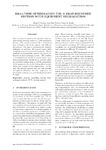Real-time optimisation for a heat-recovery section with equipment degradation

Use este enlace para citar
http://hdl.handle.net/2183/23787
A non ser que se indique outra cousa, a licenza do ítem descríbese como Atribución-NoComercial-CompartirIgual 4.0
Coleccións
- Jornadas de Automática (40ª. 2019. Ferrol) [114]
- OpenAIRE [359]
Metadatos
Mostrar o rexistro completo do ítemTítulo
Real-time optimisation for a heat-recovery section with equipment degradationData
2019Cita bibliográfica
Marcos, M.P., Pitarch, J.L., Prada, C. de (2019). Real-time optimisation for a heat-recovery section with equipment degradation. En XL Jornadas de Automática: libro de actas, Ferrol, 4-6 de septiembre de 2019 (pp.513-519). DOI capítulo: https://doi.org/10.17979/spudc.9788497497169.513. DOI libro: https://doi.org/10.17979/spudc.9788497497169
Resumo
[Abstract] This work aims to optimise the operation of an industrial heat-recovery section in a fibre-production factory. The section is formed by a network of heat exchangers able to be supplied with different hot sources. The goal is minimising the resource utilisation in real time (the sources usage) while satisfying a set of operational constrains. Hence, problems of economically optimal hot-sources allocation to heat exchangers arise. The problem is formulated and solved via mixed-integer non-linear programming. Furthermore, concerns about the practical implementation and the degradation of the equipment due to the fouling effect are also taken into account in the optimisation. In this way, the decision-support tool not only provides the optimal allocation, but also suggestions on which heat exchangers are potentially beneficial to be clean.
Palabras chave
Grey-box modelling
Fouling
Heat-exchanger network
RTO
Decision support
Fouling
Heat-exchanger network
RTO
Decision support
Versión do editor
Dereitos
Atribución-NoComercial-CompartirIgual 4.0
ISBN
978-84-9749-716-9






